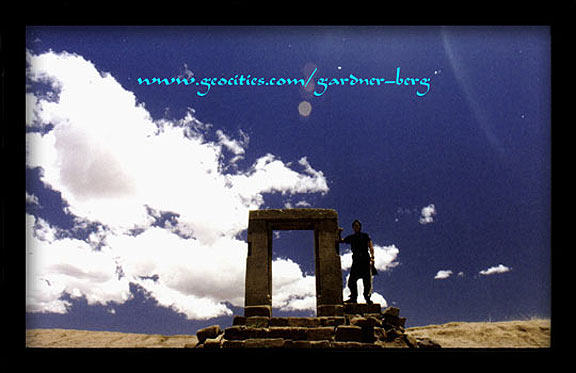
Tiwanaku, BOLIVIA
| Translate: EspaŮol - FranÁais - Deutsch - Italiano - PortuguÍs - Japanese - Korean - Chinese |

Tiwanaku, BOLIVIA
| Translate: EspaŮol - FranÁais - Deutsch - Italiano - PortuguÍs - Japanese - Korean - Chinese |

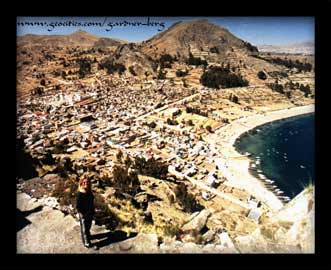 AUGUST 6, 2000 -- A bad time to cross the border to Copacabana on the Bolivian side of Lake Titicaca. There was a festival going on (La Virgen de Copacabana). But the border formalities were fast for us - the only two foreigners in a very full bus, and also the only two foreigners on the bus that needed passport stamps. Indigenous locals stayed on the bus the whole time as they drove slowly in the traffic jam toward the Bolivian border. We hurried past many confused travellers wandering in circles in the cramped immigration office. Duplicate forms split, passports stamped and we were in Bolivia. Everybody on our bus were just great. They patiently waited for us to the
AUGUST 6, 2000 -- A bad time to cross the border to Copacabana on the Bolivian side of Lake Titicaca. There was a festival going on (La Virgen de Copacabana). But the border formalities were fast for us - the only two foreigners in a very full bus, and also the only two foreigners on the bus that needed passport stamps. Indigenous locals stayed on the bus the whole time as they drove slowly in the traffic jam toward the Bolivian border. We hurried past many confused travellers wandering in circles in the cramped immigration office. Duplicate forms split, passports stamped and we were in Bolivia. Everybody on our bus were just great. They patiently waited for us to the
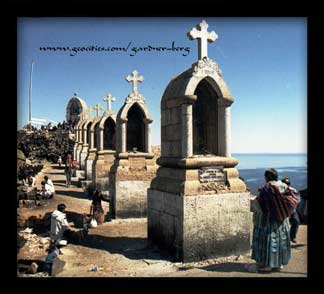 point where the conductor came to where we were in line at the office to make sure we knew where the bus was parked. Our seats were even saved for us.
point where the conductor came to where we were in line at the office to make sure we knew where the bus was parked. Our seats were even saved for us.
Copacabana, located at the southeast of Titicaca, sees a lot of sunshine during the day - but quite cold at night. With the exception of Tibet, this region is the most elevated of human habitation on the planet. While the lands of Tibet represent only mountain pastures, this Andean basin supports towns and cities, affords food for herds of cattle, llamas, vicunas and sheep, and produces annual harvests. Lake Titicaca, at 12,645ft a.s.l. is almost as large as Lake Erie in North America but its depth cannot be determined. The fossils upon the mountains that surround Titicaca leave no room to doubt that within a recent
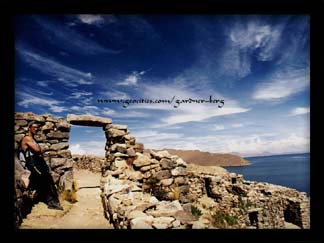 geological period, it formed a vast inland sea, extending possibly over the entire basin between the 2 ranges of the Andes. The waters now have no visible means of escape. The eastern boundary is formed by the greatest continuous snow range in the world.
geological period, it formed a vast inland sea, extending possibly over the entire basin between the 2 ranges of the Andes. The waters now have no visible means of escape. The eastern boundary is formed by the greatest continuous snow range in the world.
A strange characteristic of Lake Titicaca is that metal never rusts in its waters. You could throw a chain, anchor, or any article of ordinary iron and let it lie for weeks, and when you haul it up it will be as clean and bright as when it came from the foundry; and, what is stranger still, rust that has formed upon metallic objects elsewhere will peel off when immersed in its waters.
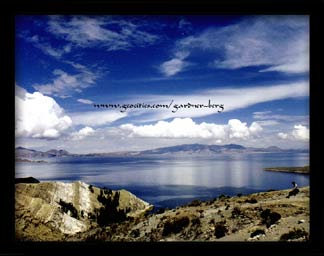
AUGUST 9, 2000 -- After an early morning walk around the outskirts of town, passing friendly locals on their way to work - greeting everyone they see,we head to Cerro Calvario where the 'Stations of the Cross' stand in line. A great view overlooking the lake can be had here.
It was disheartening witnessing the forward and rude Peruvian mestizo tourists flashing their colorful behaviour amidst the timid Bolivian locals. The differences are telling.
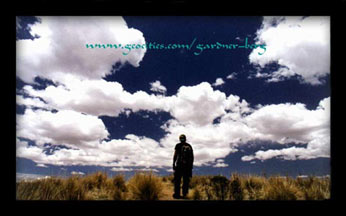 AUGUST 11, 2000 -- We catch a boat after breakfast to Isla del Sol where we would stay a couple of days. The boat drops us at the northern end of the island, then a 40 minute walk to a nearby bay (Challa) to seek cheap accomodation. Once organised and settled, it's north again to view the Inca ruins of Chincana.
AUGUST 11, 2000 -- We catch a boat after breakfast to Isla del Sol where we would stay a couple of days. The boat drops us at the northern end of the island, then a 40 minute walk to a nearby bay (Challa) to seek cheap accomodation. Once organised and settled, it's north again to view the Inca ruins of Chincana.
The next morning, a day hike south to the Inca stone stairway and its springs. A day of clear skies and great views seen from along the island's backbone.
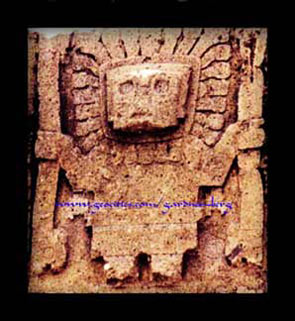 AUGUST 13, 2000 -- A cold rain falls on the island this morning and our walk back to the boat landing was a contrast to when we arrived. A light cover of ice freshened the rarified air and patched our surroundings with white. During our return to Copacabana, a stop at Isla de la Luna nearby to allow a visit to another ruin site of a temple and nunnery.
AUGUST 13, 2000 -- A cold rain falls on the island this morning and our walk back to the boat landing was a contrast to when we arrived. A light cover of ice freshened the rarified air and patched our surroundings with white. During our return to Copacabana, a stop at Isla de la Luna nearby to allow a visit to another ruin site of a temple and nunnery.
During a period berween 800 BC and 1200 AD, the Tiwanaku became one of the most important cultures of Andean civilisation. At its height, from 450 to 900 AD, its influence spread throughout much of Bolivia and Peru and parts of Chile and Argentina. Some of the Tiwanaku gods were ancestors of those worshipped by the Incas. Supposedly merging successfully with the militant Huari (Wari) culture
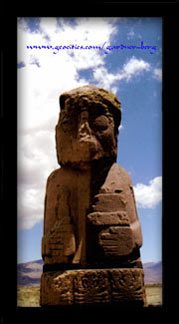 (based in the central highlands), this combined movement made considerable progress in art and technology, building roads, terraces and irrigation canals across the country. The rising efficiency of the running of their empire eventually collapsed partly due to infighting between regional kingdoms sqabbling over land and power.
(based in the central highlands), this combined movement made considerable progress in art and technology, building roads, terraces and irrigation canals across the country. The rising efficiency of the running of their empire eventually collapsed partly due to infighting between regional kingdoms sqabbling over land and power.
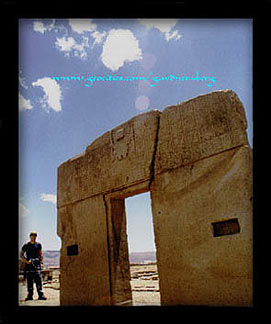 SEPTEMBER 15, 2000 -- (Noon) Our backpacks packed, accomodation payment settled, we say our goodbyes and walk to a section of town to the next bus heading to Bolivia's capital - La Paz (3 and a half hours away). It was a relaxing, pleasant ride involving a small water crossing at San Pedro/San Pablo
gap and the ever-present Cordillera in the distance. An interesting surprise; the highway across the plateau leads to the brink of a canyon 1100 ft deep, whose walls are almost vertical, and the colour and topography resembles the Grand Canyon in Colorado, USA. The approach was impressive; dipping into the 'bowl' from El Alto and zig-zagging down from its rim. At the foot of this huge gorge lies La Paz city.
SEPTEMBER 15, 2000 -- (Noon) Our backpacks packed, accomodation payment settled, we say our goodbyes and walk to a section of town to the next bus heading to Bolivia's capital - La Paz (3 and a half hours away). It was a relaxing, pleasant ride involving a small water crossing at San Pedro/San Pablo
gap and the ever-present Cordillera in the distance. An interesting surprise; the highway across the plateau leads to the brink of a canyon 1100 ft deep, whose walls are almost vertical, and the colour and topography resembles the Grand Canyon in Colorado, USA. The approach was impressive; dipping into the 'bowl' from El Alto and zig-zagging down from its rim. At the foot of this huge gorge lies La Paz city.
We find accomodation in the northwestern sector of the city centre close to a large indoor/outdoor market. We decide to stay here a while to ride out some altitude sickness with rest. Unlike Lima, Peru the weather here in La Paz is clear which seemingly reflects a pleasant attitude among its city dwellers.
Photos and Text Copyright © 1999-2001 Gardner-Berg. All rights reserved.
Sources of Further Reading-
Abercrombie, Thomas A. "Pathways of Memory and Power: Ethnography and History Among the Andean People" 1998.
Benner, Susan E. "Fire from the Andes: Short Fiction by Women from Bolivia, Ecuador and Peru" 1998
Kolata, Alan L. "The Tiwanaku: Portrait of an Andean Civilization"
Kolata, Alan L. "Valley of the Spirits: A Journey into the Lost Realm of the Aymara" 1996.
Luykx, Aurolyn and Foley, Douglas. "The Citizen Factory: Schooling and Cultural Production in Bolivia" 1998.
Salles-Reese, Veronica. "From Viracocha to the Virgin of Copacabana: Representation of the Sacred at Lake Titicaca" 1997
Schull, William J. and Rothammer, F. "The Aymara: Strategies of Human Adaption to a Rigorous Environment" 1990.

